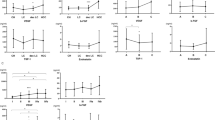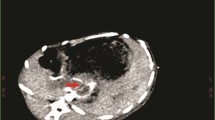Summary
The expression and implication of vascular endothelial growth factor (VEGF) and matrix metalloproteinase-9 (MMP-9) in residual hepatic tumor cells after lipiodol embolization were investigated. Two weeks after transplantation of VX2 tumor cells into the livers of rabbits, a xenograft model of the human hepatic neoplasm was successfully established. Forty rabbits were randomly divided into control group (n=20) and lipiodol group (n=20). For the control group, 1 mL normal saline was injected through the gastroduodenal artery, whereas 0.3 mL/kg lipiodol was applied for the lipiodol group. One week after embolization, the expression level of VEGF in the plasma was measured by using enzyme-linked immunosorbent assay (ELISA). A three-step immunohistochemical technique (ABC) was employed to detect the protein levels of VEGF and MMP-9 and the quantitative PCR for their mRNA levels was performed in the residual tumor cells. The VEGF in the plasma was significantly higher in the lipiodol group (1.42±0.29 ng/mL) than in the control group (1.12±0.21 ng/mL) (P<0.01). Moreover, the positive rate of VEGF protein in the residual tumor cells was significantly higher in the lipiodol group (62.13%±7.69%) than in the control group (53.16%±9.17%) (P<0.05). Similarly, the MMP-9 expression in the residual tumor cells was higher in the lipiodol group. The mRNA levels of VEGF (2.9313±2.4231) and MMP-9 (3.5721±1.6107) in the lipiodol group were significantly higher than those in the control group (1.5728±0.9453 and 1.7573±1.0641, respectively, P<0.05). Therefore, it was reasonable to speculate that the increased expression of VEGF and MMP-9 in residual hepatic tumor cells and tumor angiogenesis post-embolization would be responsible for the increased metastatic potentiality and invasiveness of these cells.
Similar content being viewed by others
References
Semela D, Heim M. Hepatocellular carcinoma. Ther Umsch, 2011,68(4):213–217
Takavasu K, Arii S, Ikai I, et al. Prospective cohort study of transarterial chemoembolization for unresectable hepatocellular carcinoma in 8510 patients. Gastroenterology, 2006,131(2):461–469
Song MJ, Park CH, Kim JD, et al. Drug-eluting bead loaded with doxorubicin versus conventional lipiodol-based transarterial chemoembolization in the treatment of hepatocellular carcinoma: a case-control study of Asian patients. Eur J Gastroenterol Hepatol, 2011,23(6):521–527
Okabe K, Beppu T, Haraoka K, et al. Safety and short-term therapeutic effects of miriplatin-lipiodol suspension in transarterial chemoembolization (TACE) for hepatocellular carcinoma. Anticancer Res, 2011,31(9):2983–2988
Sergio A, Cristofori C, Cardin R, et al. Transcatheter arterial chemoembolization (TACE) in hepatocellular carcinoma (HCC): the role of angiogenesis and invasiveness. Am J Gastroenterol, 2008,103(4):914–921
Mareel M, Constantino S. Ecosystems of invasion and metastasis in mammary morphogenesis and cancer. Int J Dev Biol, 2011,55(7–9):671–684
Weis SM, Cheresh DA. Tumor angiogenesis: molecular pathways and therapeutic targets. Nat Med, 2011,17(11):1359–1370
Shen YC, Hsu C, Cheng AL. Molecular targeted therapy for advanced hepatocellular carcinoma: current status and future perspectives. J Gastroenterol, 2010,45(8):794–807
Chen L, Shi Y, Jiang CY, et al. Coexpression of PDGFR-alpha, PDGFR-beta and VEGF as a prognostic factor in patients with hepatocellular carcinoma. Int J Biol Markers, 2011,26(2):108–116
Sullu Y, Demirag GG, Yildirim A, et al. Matrix metalloproteinase-2 (MMP-2) and MMP-9 expression in invasive ductal carcinoma of the breast. 2 (MMP-2) and MMP-9 expression in invasive ductal carcinoma of the breast. Pathol Res Pract, 2011,207(12):747–753
Xiang ZL, Zeng ZC, Fan J, et al. Gene expression profiling of fixed tissues identified hypoxia-inducible factor-1α, VEGF, and matrix metalloproteinase-2 as biomarkers of lymph node metastasis in hepatocellular carcinoma. Clin Cancer Res, 2011,17(16):5463–5472
Bausch D, Pausch T, Krauss T, et al. Neutrophil granulocyte-derived MMP-9 is a VEGF independent functional component of the angiogenic switch in pancreatic ductal adenocarcinoma. Angiogenesis, 2011,14(3):235–243
Gu T, Li CX, Feng Y, et al. Trans-arterial gene therapy for hepatocellular carcinoma in a rabbit model. World J Gastroenterol, 2007,13(14):2113–2117
Ke S, Ding XM, Kong J, et al. Low temperature of radiofrequency ablation at the target sites can facilitate rapid progression of residual hepatic VX2 carcinoma. J Transl Med, 2010,8:73–83
Xu T, Chen XP, Li D, et al. Expression of EMMPRIN in rabbit VX2 liver tumor tissue and significance. Zhonghua Shiyan Waike Zazi (Chinese), 2007,24(1):37–39
Xu T, Chen XP, Guo YX, et al. Expression of MT1-MMP and its significance in rabbit VX2 tumor tissues after transarterial embolization with hydroxyapatite nanoparticles. Zhonghua Waike Zazi (Chinese), 2008,46(8):606–609
Byrne AM, Bouchier-Hayes DJ, Harmey JH. Angiogenic and cell survival functions of vascular endothelial growth factor (VEGF). J Cell Mol Med, 2005,9(4):777–794
Carmeliet P. VEGF as a key mediator of angiogenesis in cancer. Oncology, 2005,69(3):4–10
Chen Y, Jiang L, She F, et al. Vascular endothelial growth factor-C promotes the growth and invasion of gallbladder cancer via an autocrine mechanism. Mol Cell Biochem, 2010,345(1–2):77–89
Kolev Y, Uetake H, Iida S, et al. Prognostic significance of VEGF expression in correlation with COX-2, microvessel density, and clinicopathological characteristics in human gastric carcinoma. Ann Surg Oncol, 2007,14(10):2738–2747
Zhu AX, Duda DG, Sahani DV, et al. HCC and angiogenesis: possible targets and future directions. Nat Rev Clin Oncol, 2011,8(5):292–301
Huang X, Huang S, Zhang F, et al. Lentiviral-mediated Smad4 RNAi promotes SMMC-7721 cell migration by regulation of MMP-2, VEGF and MAPK signaling. Mol Med Report, 2010,3(2):295–299
Orlichenko LS, Radisky DC. Matrix metalloproteinases stimulate epithelial-mesenchymal transition during tumor development. Clin Exp Metastasis, 2008,25(6):593–600
Morrison C, Mancini S, Cipollone J, et al. Microarray and proteomic analysis of breast cancer cell and osteoblast co-cultures: role of osteoblast matrix metalloproteinase (MMP)-13 in bone metastasis. J Biol Chem, 2011,286(39):34 271–34 285
Golubkov VS, Chekanov AV, Savinov AY, et al. Membrane type-1 matrix metalloproteinase confers aneuploidy and tumorigenicity on mammary epithelial cells. Cancer Res, 2006,66(21):10 460–10 465
Hu F, Wang C, Guo S, et al. δEF1 promotes osteolytic metastasis of MDA-MB-231 breast cancer cells by regulating MMP-1 expression. Biochim Biophys Acta, 2011,1809(3):200–210
Zhang W, Yang HC, Wang Q, et al. Clinical value of combined detection of serum matrix metalloproteinase-9, heparanase, and cathepsin for determining ovarian cancer invasion and metastasis. Anticancer Res, 2011,31(10):3423–3428
der Jagt MF, Wobbes T, Strobbe LJ, et al. Metalloproteinases and their regulators in colorectal cancer. J Surg Oncol, 2010,101(3):259–269
Bendardaf R, Buhmeida A, Hilska M, et al. MMP-9 (gelatinase B) expression is associated with disease-free survival and disease-specific survival in colorectal cancer patients. Cancer Invest, 2010,28(1):38–43
Chen JS, Wang Q, Fu XH, et al. Involvement of PI3K/PTEN/AKT/mTOR pathway in invasion and metastasis in hepatocellular carcinoma: Association with MMP-9. Hepatol Res, 2009,39(2):177–186
Saharinen P, Eklund L, Pulkki K, et al. VEGF and angiopoietin signaling in tumor angiogenesis and metastasis. Trends Mol Med, 2011,17(7):347–362
Van Hinsbergh VW, Eaglse MA, Quax PH. Pericellular proteases in angiogenesis and vasculogenesis. Arterioscler Thromb Vasc Biol, 2006,26(4):716–728
Tsai MY, Yang RC, Wu HT, et al. Anti-angiogenic effect of Tanshinone IIA involves inhibition of matrix invasion and modification of MMP-2/TIMP-2 secretion in vascu lar endothelial cells. Cancer Lett, 2011,310(2):198–206
Kim CH, Lee JH, Won JH, et al. Mesenchymal stem cells improve wound healing in vivo via early activation of matrix metalloproteinase-9 and vascular endothelial growth factor. J Korean Med Sci, 2011,26(6):726–733
Ortega N, Wang K, Ferrara N, et al. Complementary interplay between matrix metalloproteinase-9, vascular endothelial growth factor and osteoclast function drives endochondral bone formation. Dis Model Mech, 2010,3(3–4):224–235
Yang P, Yuan W, He J, et al. Overexpression of EphA2, MMP-9, and MVD-CD34 in hepatocellular carcinoma: Implications for tumor progression and prognosis. Hepatol Res, 2009,39(12):1169–1177
Man K, Ng KT, Xu A, et al. Suppression of liver tumor growth and metastasis by adiponectin in nude mice through inhibition of tumor angiogenesis and downregulation of Rho kinase/IFN-inducible protein 10/matrix metalloproteinase 9 signaling. Clin Cancer Res, 2010,16(3):967–977
Hou YK, Wang Y, Cong WM, et al. Expression of tumor metastasis-suppressor gene KiSS-1 and matrix metalloproteinase-9 in portal vein tumor thrombus of hepatocellular carcinoma. Ai Zheng, 2007,26(6):591–595
Zhang Q, Chen X, Zhou J, et al. CD147, MMP-2, MMP-9 and MVD-CD34 are significant predictors of recurrence after liver transplantation in hepatocellular carcinoma patients. Cancer Biol Ther, 2006,5(7):808–814
Takavasu K, Arii S, Ikai I, et al. Prospective cohort study of transarterial chemoembolization for unresectable hepatocellular carcinoma in 8510 patients. Gastroenterology, 2006,131(2):461–469
Liapi E, Georgiades CC, Hong K, et al. Transcatheter arterial chemoembolization: current technique and future promise. Tech Vasc Interv Radiol, 2007,10(1):2–11
Wang B, Xu H, Gao ZQ, et al. Increased expression of vascular endothelial growth factor in hepatocellular carcinoma after transcatheter arterial chemoembolization. Acta Radiol, 2008,49(5):523–529
Shim JH, Park JW, Kim JH, et al. Association between increment of serum VEGF level and prognosis after transcatheter arterial chemoembolization in hepatocellular carcinoma patients. Cancer Sci, 2008, 99(10):2037–2044
Rhee TK, Young JY, Larson AC, et al. Effect of transcatheter arterial embolization on levels of hypoxia-inducible factor-1alpha in rabbit VX2 liver tumors. J Vasc Interv Radiol, 2011,18(5):639–645
Deng G, Zhao DL, Li GC, et al. Combination therapy of transcatheter arterial chemoembolization and arterial administration of antiangiogenesis on VX2 liver tumor. Cardiovasc Intervent Radiol, 2011,34(4):824–832
Janani P, Sivakumari K, Geetha A, et al. Bacoside A downregulates matrix metalloproteinases 2 and 9 in DEN-induced hepatocellular carcinoma. Cell Biochem Funct, 2010,28(2):164–169
Author information
Authors and Affiliations
Corresponding authors
Additional information
This project was supported by grants from the Natural Science Foundation of Shandong Province of China (No. Y2007C102), and the Medical Science and Technology Development Foundation of Shandong Province of China (No. 2007H2071).
Rights and permissions
About this article
Cite this article
Shi, Yl., Xu, T., Li, Lp. et al. Over-expression of VEGF and MMP-9 in residual tumor cells of hepatocellular carcinoma after embolization with lipidol. J. Huazhong Univ. Sci. Technol. [Med. Sci.] 33, 90–95 (2013). https://doi.org/10.1007/s11596-013-1077-z
Received:
Published:
Issue Date:
DOI: https://doi.org/10.1007/s11596-013-1077-z




